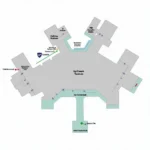Airports have come a long way since their humble beginnings as simple landing strips. Today, they’re bustling hubs of activity, serving as gateways to destinations around the world and driving economic growth in their surrounding communities. But what’s driving this evolution? What makes modern airports so much more than just places to take off and land? In this article, we’ll explore the exciting developments transforming airports into dynamic, interconnected spaces that cater to the needs of travelers and businesses alike.
From Simple Strips to Integrated Hubs: A Historical Perspective
The first airports were little more than open fields with a runway and a few basic facilities. The focus was solely on the practicalities of flight: getting aircraft safely into the air and back down again. As air travel became more popular, airports started to expand and evolve. Passenger terminals were built, and amenities like restaurants, shops, and lounges were added. The concept of the “airport” began to take shape.
“Airports have always been dynamic entities, evolving to meet the demands of the changing world.” – Dr. Emily Carter, Aviation History Professor
Embracing Technology: The Rise of Smart Airports
The 21st century has brought a technological revolution to airports. From self-service check-in kiosks to automated baggage handling systems, technology is making the travel experience more seamless and efficient. This trend is driving the emergence of “smart airports” – facilities that leverage data and analytics to enhance every aspect of the passenger journey.
The Benefits of Smart Airports:
- Improved Security: Biometric identification and advanced screening technologies make airport security faster and more effective.
- Personalized Experience: Data-driven insights allow airports to tailor services and amenities to individual traveler preferences.
- Increased Efficiency: Real-time data helps optimize airport operations, reducing wait times and improving the flow of passengers and baggage.
Beyond the Gate: Connecting Airports to the City
Modern airports are increasingly seen as integral parts of the urban fabric, not just isolated transportation hubs. Integrated urban planning and infrastructure development are creating seamless connections between airports and surrounding cities. This means:
- Improved Transportation Links: High-speed rail lines, dedicated bus routes, and expanded taxi services provide efficient and convenient access to airports.
- Commercial Development: Airport areas are attracting commercial and business development, creating jobs and boosting economic activity.
- Urban Renewal: Airports are becoming catalysts for urban renewal, revitalizing surrounding neighborhoods and promoting tourism.
The Future of Airports: What to Expect
The evolution of airports is far from over. As air travel continues to grow, we can expect to see even more innovative technologies and designs emerging in the future. Here are some trends to watch:
- Sustainable Airports: Sustainability is becoming a key focus, with airports adopting eco-friendly designs, renewable energy sources, and carbon-neutral operations.
- Autonomous Vehicles: Self-driving vehicles and drones are expected to play a larger role in airport transportation and logistics.
- Personalized Experiences: Advances in AI and machine learning will allow airports to deliver truly personalized and interactive experiences for travelers.
“The future of airports lies in creating a truly seamless and enjoyable travel experience for passengers, while also contributing to the sustainable development of the communities they serve.” – Mr. John Davis, Aviation Industry Consultant
Conclusion
Airports are no longer just places to board a plane. They’re dynamic, interconnected spaces that are shaping the future of travel and urban development. As technology advances and traveler expectations evolve, we can expect to see even more exciting transformations in the world of airports in the years to come.
